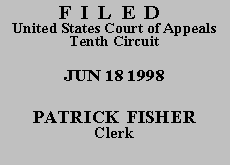

| UNITED STATES OF AMERICA,
Plaintiff-Appellee, v. REGINALD LADON SLOAN, also known as - Wolf, also known as Reggie Sloan, Defendant-Appellant. |
|
Reginald Ladon Sloan appeals the district court's order dismissing his motion to vacate, set aside, or correct sentence under 28 U.S.C. § 2255. We deny a certificate of appealability and dismiss the appeal.
Sloan's convictions for possession with intent to distribute cocaine base and using a telephone to facilitate distribution of cocaine base were affirmed on September 13, 1995, in United States v. Sloan, 65 F.3d 152 (10th Cir. 1995), and his convictions became final upon expiration of the time for filing a petition for certiorari in the Supreme Court. See Griffin v. Kentucky, 479 U.S. 314, 321 n.6 (1987); United States v. Cuch, 79 F.3d 987, 991 n.9 (10th Cir. 1996). Sloan signed his § 2255 motion on April 23, 1997, but filed it by delivery to prison authorities for forwarding to the clerk of the district court on April 24, 1997. See Houston v. Lack, 487 U.S. 266 (1988). The district court dismissed the motion as untimely under United States v. Simmonds, 111 F.3d 737 (10th Cir. 1997), because it was not filed within a year of the April 24, 1996, effective date of the Antiterrorism and Effective Death Penalty Act of 1996 (AEDPA).
Sloan contends application of the Simmonds rule is impermissibly retroactive and violates the constitutional prohibition against ex post facto laws. Before the AEDPA, a federal prisoner could bring a § 2255 action at any time. The AEDPA amended § 2255 to impose a time limit precluding prisoners from bringing § 2255 actions more than one year after their convictions became final. In Simmonds, we concluded application of the one-year limitation period to bar § 2255 actions by prisoners whose convictions became final before the AEDPA took effect would be impermissibly retroactive. To avoid impermissible retroactivity, we concluded such prisoners must be given a reasonable amount of time after the effective date of the statute to bring their actions. We further concluded the statutory one-year period was a reasonable time and held "prisoners whose convictions became final on or before April 24, 1996 must file their § 2255 motions before April 24, 1997." 111 F.3d at 746.
An ex post facto law is one that retroactively alters the definition of a crime or increases the punishment for criminal conduct. Lynce v. Mathis, 117 S. Ct. 891, 896 (1997). Simmonds does neither.
We conclude Sloan has failed to make a substantial showing of the denial of a constitutional right required for issuance of a certificate of appealability under 28 U.S.C. § 2253(c)(2). We DENY a certificate of appealability and DISMISS the appeal. The mandate shall issue forthwith.
Entered for the Court
Mary Beck Briscoe
Circuit Judge
*. This order and judgment is not binding precedent, except under the doctrines of law of the case, res judicata, and collateral estoppel. The court generally disfavors the citation of orders and judgments; nevertheless, an order and judgment may be cited under the terms and conditions of 10th Cir. R. 36.3.